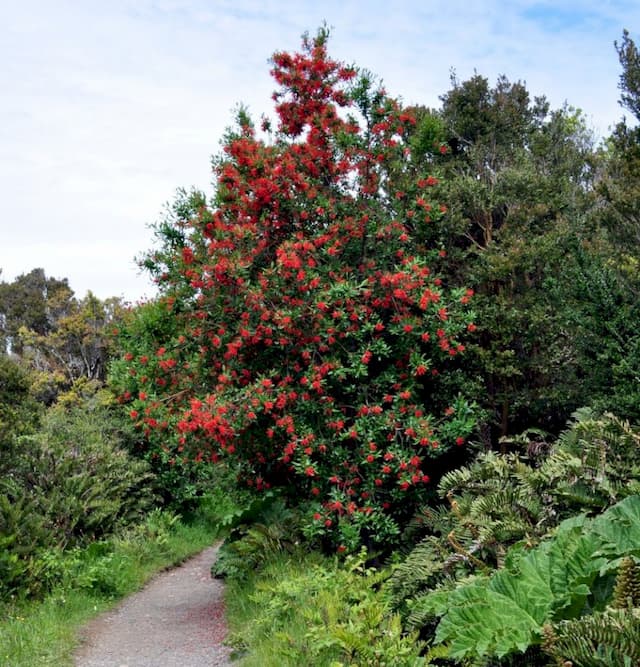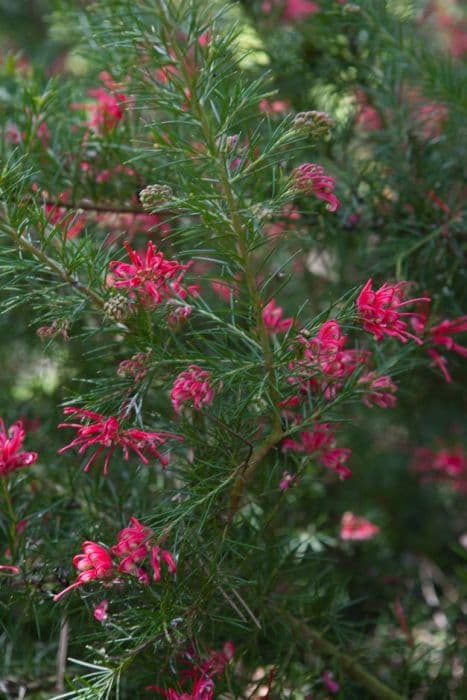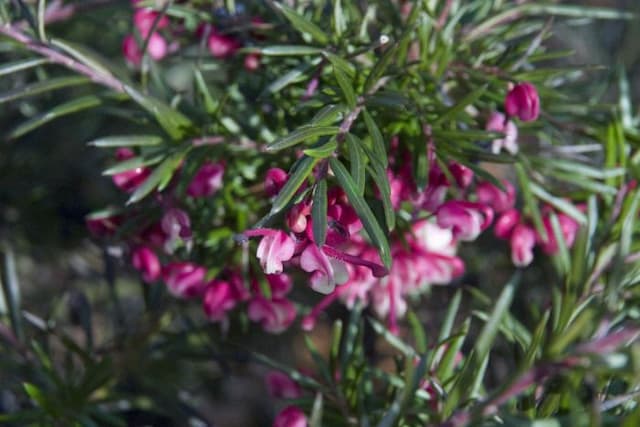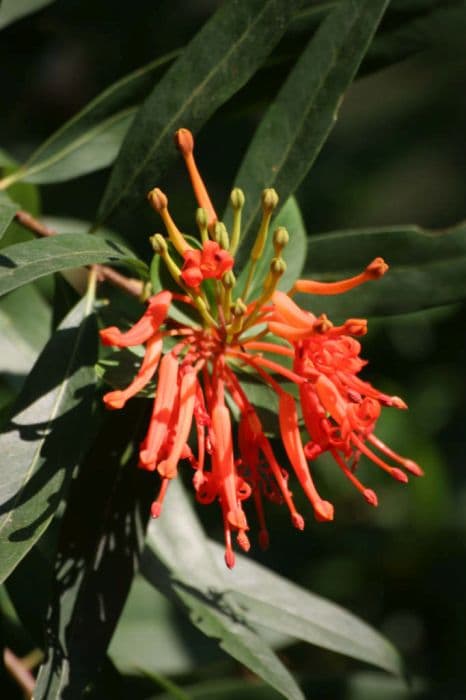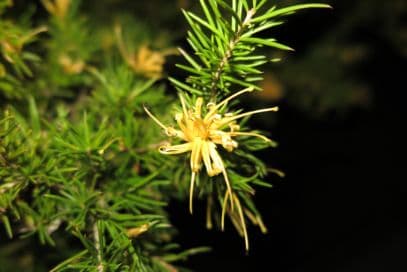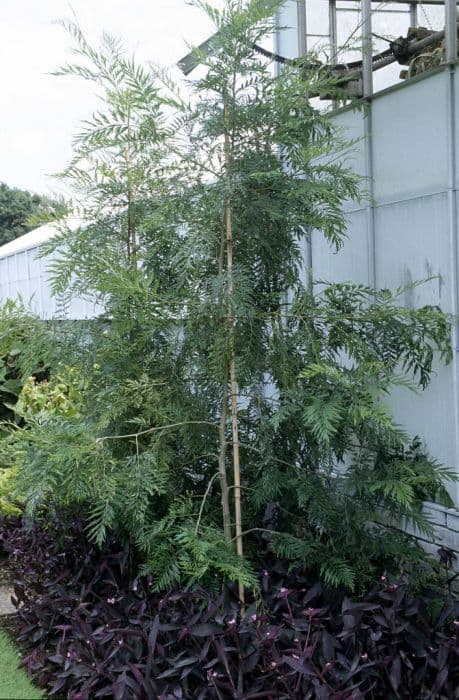Inca Gold Conebush Leucadendron 'Inca Gold'

ABOUT
Leucadendron 'Inca Gold' is a striking plant known for its vibrant, showy bracts and lush foliage. The plant features spirals of green leaves that form a dense backdrop for its most distinct characteristic, the colorful bracts that range in hue from bright yellow to rich gold. These bracts resemble petals and surround the true flowers, which are rather inconspicuous in comparison to the flamboyant bracts. The leaves of the Inca Gold are narrow and pointed, with a leathery texture and a glossy sheen that catches the light. They're arranged in a whorled pattern that adds to the plant's overall architectural interest. As the seasons change, so may the color intensity of the bracts and foliage, often becoming even more vibrant when the weather is cooler. The Inca Gold is well-regarded for its long-lasting floral display which is particularly eye-catching when the plant is in full bloom. These colorful bracts can also be used in floral arrangements, adding a burst of sunshine to any bouquet. The plant's overall appearance is one of robust vitality and radiant color, making it a popular choice for gardens or as a focal point in landscapes.
About this plant
 Names
NamesFamily
Proteaceae.
Synonyms
Inca Gold Conebush, Inca Gold Leucadendron.
Common names
Leucadendron 'Inca Gold'.
 Toxicity
ToxicityTo humans
Inca Gold is not commonly listed as a toxic plant to humans. It does not contain any well-known toxic principles that would cause poisoning upon ingestion. However, as with many plants, sensitive individuals might experience an allergic reaction or dermatitis on contact with plant sap or if ingested, might cause stomach upset due to its non-dietary nature.
To pets
Inca Gold is not commonly known to be toxic to pets. There is limited information indicating toxicity of this specific plant towards pets such as dogs and cats. As with humans, pets may experience gastrointestinal upset if they ingest parts of the plant due to its non-food nature. Always exercise caution and prevent pets from eating ornamental plants as individual reactions can vary.
 Characteristics
CharacteristicsLife cycle
Perennials
Foliage type
Evergreen
Color of leaves
Green
Flower color
Yellow
Height
5-6 feet (1.5-1.8 meters)
Spread
5-6 feet (1.5-1.8 meters)
Plant type
Shrub
Hardiness zones
8-10
Native area
South Africa
Benefits
 General Benefits
General Benefits- Drought Tolerance: Leucadendron 'Inca Gold' is highly tolerant to dry conditions, making it suitable for water-wise gardens.
- Low Maintenance: It requires minimal care once established, needing only occasional pruning and watering.
- Landscape Design Versatility: Its bright yellow bracts add color and texture to various landscape designs.
- Long-lasting Cut Flowers: The branches and colorful bracts are excellent for cut flower arrangements due to their long vase life.
- Attracts Wildlife: The flowers can attract birds, especially nectar-feeding species, contributing to local biodiversity.
- Fire Resistant: This plant is considered fire-resistant, making it a good choice for fire-prone areas.
- Year-Round Interest: It provides visual interest throughout the year with its evergreen foliage and seasonal color changes.
- Adaptability: It can adapt to different soil types, provided they are well-draining.
- Wind Resistance: Leucadendron 'Inca Gold' is tolerant of windy conditions, perfect for coastal and exposed sites.
- Frost Tolerance: It has a degree of frost tolerance, making it suitable for cooler climates.
 Medical Properties
Medical PropertiesThis plant is not used for medical purposes.
 Air-purifying Qualities
Air-purifying QualitiesThis plant is not specifically known for air purifying qualities.
 Other Uses
Other Uses- Craft material: The branches and colorful bracts of Inca Gold can be used in arts and crafts such as making wreaths or adding a natural flair to handmade greeting cards.
- Photography subject: With their striking colors and structural forms, Inca Gold can serve as an interesting and exotic subject for botanical photographers and artists.
- Educational tool: Botany educators can use Inca Gold to teach students about plant adaptations, especially those found in the fynbos biome of South Africa.
- Dye source: The colorful bracts of the Inca Gold may be used in the process of natural dyeing to impart colors on fabrics or yarns.
- Floral art: Its stiff structure and bright colors make Inca Gold an excellent choice for use in ikebana, the Japanese art of flower arrangement.
- Culinary decoration: While not edible, the flowers and bracts can be used for ornamental purposes in plating and presentation of gourmet dishes.
- Theme gardens: As a representation of South African flora, Inca Gold can be included in theme gardens or cultural displays dedicated to the region's vegetation.
- Seasonal décor: The Inca Gold’s vibrant colors make it a great addition to autumnal displays, complementing the traditional fall color palette.
- Private collections: Plant enthusiasts may cultivate this variety as part of a private collection that showcases different Leucadendron cultivars or unique plant specimens.
- Film and stage props: Inca Gold can be used in set design for movies or theater productions requiring exotic or other-worldly plant life.
Interesting Facts
 Feng Shui
Feng ShuiThe plant Leucadendron is not used in Feng Shui practice.
 Zodiac Sign Compitability
Zodiac Sign CompitabilityThe plant Leucadendron is not used in astrology practice.
 Plant Symbolism
Plant Symbolism- Resilience and Strength: Leucadendron 'Inca Gold', similar to other members of the Proteaceae family, is known for its ability to withstand challenging conditions and poor soils, symbolizing the ability to endure and stay strong despite adversity.
- Transformation and Change: This plant is termed 'Inca Gold', evoking the richness and preciousness of gold while also referring to the historical Inca civilization, which was known for its wealth, ingenuity, and dramatic history, symbolizing transformation and the power of change.
- Rarity and Uniqueness: The Leucadendron 'Inca Gold' is not a common plant in many gardens, adding an exclusive touch and symbolizing rarity and the value of having a unique character or appearance.
- Beauty and Splendor: With its striking yellow bracts and cone-like inflorescences, Leucadendron 'Inca Gold' can symbolize beauty and splendor, celebrating the visual pleasure and aesthetics of the natural world.
 Water
WaterInca Gold Leucadendron requires moderate watering. Water the plant deeply until moisture seeps out of the bottom of the pot but then allow the soil to dry out between waterings. This plant can tolerate some drought conditions but performs best when the soil is kept consistently moist, not waterlogged. You should expect to water your Inca Gold roughly once every 1 to 2 weeks, using approximately 1 gallon of water each time during the growing season. Reduce watering frequency in the winter months when the plant's growth slows down.
 Light
LightInca Gold Leucadendron thrives in full sun conditions, requiring at least six hours of direct sunlight daily. Ideally, place the plant in a location where it can enjoy morning sunlight and a bit of shade during the hottest part of the afternoon in warmer climates. However, it is quite adaptable and can also handle being in a bright spot with direct sun throughout the day.
 Temperature
TemperatureInca Gold Leucadendron prefers to be grown in temperatures ranging between 50°F and 70°F. It can withstand cooler temperatures down to about 25°F, but the ideal is to avoid prolonged exposure to freezing conditions. During hot summers, ensure that temperatures don’t consistently exceed 90°F as it could stress the plant.
 Pruning
PruningPruning the Inca Gold Leucadendron is essential for maintaining its shape and encouraging the growth of the colorful bracts it is known for. Prune in late winter or early spring before the new growth starts. Remove any dead or damaged branches and prune lightly to shape the plant. Annual pruning is often enough, but you may prune occasionally during the growing season to remove spent flowers.
 Cleaning
CleaningNot needed
 Soil
SoilInca Gold Leucadendron thrives in a well-draining, acidic soil mix with a pH between 5.5 and 6.5. A suitable soil recipe includes a combination of peat, perlite, and sand to ensure adequate drainage and aeration. The soil should not retain excessive moisture, which can lead to root rot.
 Repotting
RepottingInca Gold Leucadendron should be repotted every 2 to 3 years to refresh the soil and accommodate root growth. Repotting is typically done in the spring, before the onset of the growing season. Ensure to use fresh acidic soil mix when repotting to maintain optimum growth.
 Humidity & Misting
Humidity & MistingInca Gold Leucadendron prefers moderate humidity levels, ideally between 40% to 60%. It can tolerate lower humidity conditions, but excessive dry air may lead to leaf desiccation, so it is important to avoid placing the plant near heating vents or arid environments.
 Suitable locations
Suitable locationsIndoor
Keep in bright, indirect light and cooler temps.
Outdoor
Full sun; protect from frost; well-draining, acidic soil.
Hardiness zone
9-11 USDA
 Life cycle
Life cycleLeucadendron 'Inca Gold', also known as Cone Bush, begins its life cycle as a seed, typically requiring well-drained soil and full sun exposure for germination. The seedling stage follows, where the plant starts to establish a root system and first true leaves appear. As it transitions to the juvenile phase, the Cone Bush develops a more robust root structure and foliage, becoming more resilient to environmental conditions. During the mature stage, the plant exhibits vigorous growth, producing its distinctive yellow bracts and cones that are often mistaken for flowers. In its reproductive phase, the plant's cones release seeds, which can be either dispersed naturally or collected for cultivation. After many years, typically reaching up to fifteen years or more, the Cone Bush may eventually enter senescence, where growth slows and the plant begins to decline, completing its life cycle.
 Propogation
PropogationPropogation time
Spring-Early Summer
For the Leucadendron 'Inca Gold', also known as Inca Gold Conebush, the most popular method of propagation is by taking semi-hardwood cuttings. This is typically done in the late summer or early fall, when the plants have partially matured wood from the current year's growth. Cuttings should be about 4 to 6 inches (10 to 15 centimeters) long with several leaves removed from the bottom half. The base of the cutting is often dipped in a rooting hormone to increase the chance of successful rooting before being planted in a well-draining, sterile potting mix. The cuttings then need to be placed in a warm, humid environment out of direct sunlight, such as a propagation box or under a misting system, to encourage root development. It usually takes several weeks for roots to form, after which the new plants can be gradually acclimatized to less humid conditions before being transplanted.

